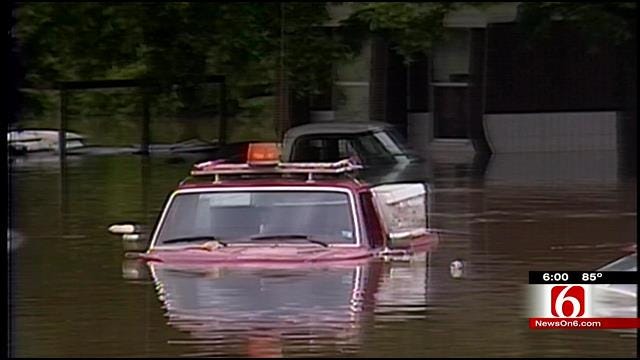Tulsa's Response To '84 Memorial Day Flood Sets Engineering Standard
It started when a huge storm system stalled over Tulsa. It rained nonstop for eight hours producing 15 inches of rain.Friday, May 23rd 2014, 6:23 pm
This is the second driest year to this point for Tulsa. Skiatook Lake is more than 11.5 feet below normal.
But it was a much different story over the Memorial Day weekend 30 years ago. Afterward, Tulsa set a nationwide standard for flood control.
It started when a huge storm system stalled over Tulsa. It rained nonstop for eight hours producing 15 inches of rain.
The result was catastrophic.
Nearly 6,000 homes and other buildings were damaged or destroyed and 20 of them were schools.
Seven thousand cars and trucks were under water. Fourteen people died, several of them drowned in their cars.
Almost 300 were injured.
Kell McClung lived in a hard-hit neighborhood at 15th Street and Garnett Road.
Late that Saturday night, Kell and his dad first noticed water pooling in their backyard.
"We didn't realize at the time the extent of the flood going on until we walked out the front door and realized the entire neighborhood was being flooded," he said. "There was people hollering, clinging to trees... It was quite memorable."
Kell walked through his old neighborhood with us.
"We discovered a couple of ladies clinging to a tree directly across the street from our home," he said. "We encouraged them not to try to cross the street because there was mailboxes, parts of cars and so much debris in the road and the water was so swift... at that point it was probably up to our waist"
Half a billion dollars in damage was left behind.
By the time of the flood, Tulsa County already had been declared a federal flood disaster area nine times in 15 years, more than any other community in the country.
But in the 30 years since, Tulsa has gone from the nation's worst to first – and America's model for flood control.
Centennial Park near Downtown is an example of the commitment made after that disastrous Memorial Day.
Today, you see examples everywhere, especially along U.S. Highway 169 and Mingo Creek.
You see it in the trails and parks built in food plains and athletic fields in storm water detention basins.
The Federal Emergency Management Agency has honored Tulsa twice as the national leader in flood plain management.
The city has come a long way, according to City of Tulsa Director of Engineering Paul Zachary.
"Flood awareness has become a culture around here," he said. "The developers are aware of it. Nobody wants to get into that. They don't want to back to where we were in the 50s, 60s and 70s."
More Like This
September 29th, 2024
September 17th, 2024
Top Headlines
December 12th, 2024
December 12th, 2024
December 12th, 2024
December 11th, 2024











